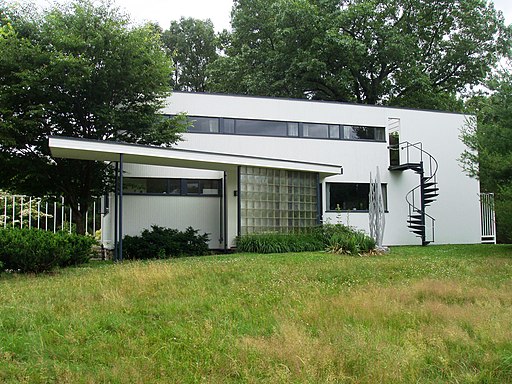DesignBuild and the Most Important Revolutionary You’ve Never Heard Of – Part 2

The Opposition Begins: The Suppression of DesignBuild
This is a continuation of our two-part blog series on Walter Gropius. For part one, please click here.
Throughout history on Earth every movement towards truth has met initially with opposition. This pattern weaves its way through the history of mankind — it is not an opinion. Generally the larger the truth and the greater its potential value for humanity — the greater the initial opposition. Gropius and DesignBuild were no exception. In this case the opposition came in several waves.
First, the Bauhaus was closed by the Nazis regime in 1933 and Gropius got out of Germany, eventually landing in the US and assuming the position of chair of the Department of Architecture within the renowned Harvard School of Design in 1937. Gropius served there at Harvard until his resignation in 1952 — the occurrence of which is glossed over with the word “retirement.”
The actual truth is that ever since Walter arrived in Cambridge he had intended to re-establish the Bauhaus School — fully with its DesignBuild ethos and foundation in both the practical workshop and individual student proficiency in design as well as the trades and art of actual building.
He was thwarted by the one man senior to him — the Dean of the Harvard School of Design, one Joseph Hudnut. Finally, after over a decade of persistence in 1950 Gropius succeeded and every first year student took Design 1, an intensive workshop-based course modeled on the Basic Course from the Bauhaus. While treasured by the students actually taking the course, after two years Hudnut succeeded in having Design 1 removed and returned Harvard’s theory-based curriculum utterly devoid of practical doingness and any proficient connection to the final product of an actual building or new space. Armchair architecture if you will–buried in theory, far from the fields of and realities of actual building. Gropius did not sit quietly, and he shared the following with the Harvard Crimson (HarvardUniversity’sstudent-run newspaper):
“Although my whole faculty is in favor of the course… it is being discontinued because the Dean is against it… I have been fighting for this course for 14 years. The faculty of the School of Architecture is of the opinion that this course is basic, and for anything which is basic the time has to be found.”
In short, Walter Gropius’ vision and intentions of a Design-Build curriculum were suppressed by the powers that be and shortly thereafter Gropius resigned.
Now freed from the constraints of the establishment, Gropius wrote in the book Scope of Total Architecture: “Complete separation of design and execution of buildings, as it is in force today, seems to be altogether artificial if we compare it to the process of building in the great periods of the past. We have withdrawn much too far from that original and natural approach, when conception and realization of a building were one indivisible process and when architect and builder were one and the same person. The architect of the future–if he wants to rise to the top again–will be forced by the trend of events to draw closer once more to the building production. If he will build up a closely cooperating team together with the engineer, the scientist and the builder, then design, construction and economy may again become an entity–a fusion of art, science and business. I will be more specific and reveal my target: The American Institute of Architects at its 1949 convention added to the mandatory rules of the Institute a new paragraph which reads: “An architect may not engage directly or indirectly in building contracting.” I have very great doubts about the wisdom of this rule which would perpetuate the separation of design and construction. Instead we should try to find an organic reunification which would return to us the mastery of the know-how in building.”
And THUS the arbitrary divide of vision, artistry and skill in design and mastery in the building process was sealed.
This arbitrary fragmentation of the natural course of design and building which has run for thousands of years through humanity was subtle – simple words are written in an AIA document in black and white (The harmful consequences of this divide could well fill a book).
Gropius continued to practice with the firm The Architect Collaborative he had helped start in 1946, creating notable buildings such as the Graduate Center at Harvard University. He was additionally elected into the National Academy of Design and sat on the MIT Visiting Committee. Gropius passed on 5 July, 1969 in Boston, Massachusetts.
The consequences:
So what have we learned?
In summary, the current role of the architect has been manipulated to fit a certain role which suits the vested interest of those in control. What actually occurred, the truth, has been twisted, masked and altered to present what they want the potential consumer to believe. In fact, the educational system has tried to make Gropius a footnote in the history of architectural styles even though this is completely what Gropius was looking to get away from! His main point with bringing modernism to the world was that architecture was progressive and should always be changing and improving. He believed the way to ensure this fluidity and expansion was to teach the subjects in such a way that the student was capable of progressing because they had the skills to accomplish their objective of better buildings. In addition, they would not be incapacitated by a devotion to and perpetual reliance on copying ages and the styles of the past.
Just a few of the consequences have been:
1.The architect today is highly marginalized and underappreciated.
2. A rate of defect 100,000% higher than any other industry that builds things.
3. A highly litigious industry revolving around these defects and no single source of accountability on a project.
Conversely, we have the potential for better buildings and, as a result, better lives.
Beyond incredible buildings and a style that has influenced the world over, Gropius’ most powerful contribution very well may be the philosophy of education he pioneered. It is based on this approach to education that generations to come will build our future.
Will this be relegated to the past or will we make the changes Gropius intended? As he stated: “The school is the servant of the workshop.”
As we have seen, Gropius represented an architect in the true sense and root of the word–master builder, or one that truly takes ownership from conception to completion of a building.
The architect of today has been redefined to mean designer. Design is the means to an end but cannot be done effectively by being completely disconnected from that which one is creating. The ramifications of this subtle and tragic arbitrary are still being felt far and wide in the building industry. The examples are legion in the form of building failures, over-budget projects, failed builds, and accidental deaths.
What stands in our way currently are the same obstacles Walter Gropius faced–an antiquated educational system built on keeping a hollow social status in play. We must break down these walls and shine the light of truth on this subject. It is a failed experiment. It is, in fact, the American University which brought the architect out of the field and office and into the classroom with a foundation made of paper and pen rather than stone and mortar.
Look at all the books where Gropius is quoted–yet the real intent of his communication is clouded behind a twisted context forwarding the message of the status quo. I ask you to simply open the front cover and take a moment to observe that specific universities funding and publishing the writing of these books. This is expressly done to fill the syllabuses of these very same institutions–perpetuating these untruths to the future generation of supposed experts in the field. Can a future generation of thinkers and creatives be crippled creatively? I think not.
Despite all of his incredible achievements and contributions to the world as a whole, Gropius still needs us to bring home his true goals. His ideas have been obscured behind shiny objects and trick mirrors. Yet Gropius’ light and vision of what can be shines on today. The DesignBuild flame has never been quelled.
Over 100 DesignBuild courses now exist in universities as candlelights to the flame Gropius lit. Soon, due to you and I making the truth known, this collective candlelight will become the light of day as the world knows it – illuminating a world that builds as nature intended – DesignBuild.
We live in an era where information and technology abound, yet the truth has lain hidden. With this truth now in hand let us use it as fuel to start a new era of education and, as a result, create the building of the future. Form does follow function. Just as design is a means to build, the way we train our industry is a means to the buildings we produce. Let us make them great–just like Walter Gropius.
Dave.
References:
https://en.wikipedia.org/wiki/Bauakademie
https://www.peoplesworld.org/article/100-years-of-bauhaus-building-for-a-society-of-equals/
https://www.getty.edu/research/exhibitions_events/exhibitions/bauhaus/new_artist/
https://www.thecrimson.com/article/1952/2/23/hudnut-drops-design-1-based-on/
https://www.thecrimson.com/article/1952/9/15/gropius-resignation-bares-design-school-hassel/
https://en.wikipedia.org/wiki/Journeyman
https://study.com/academy/lesson/modernism-in-architecture-definition-history.html


